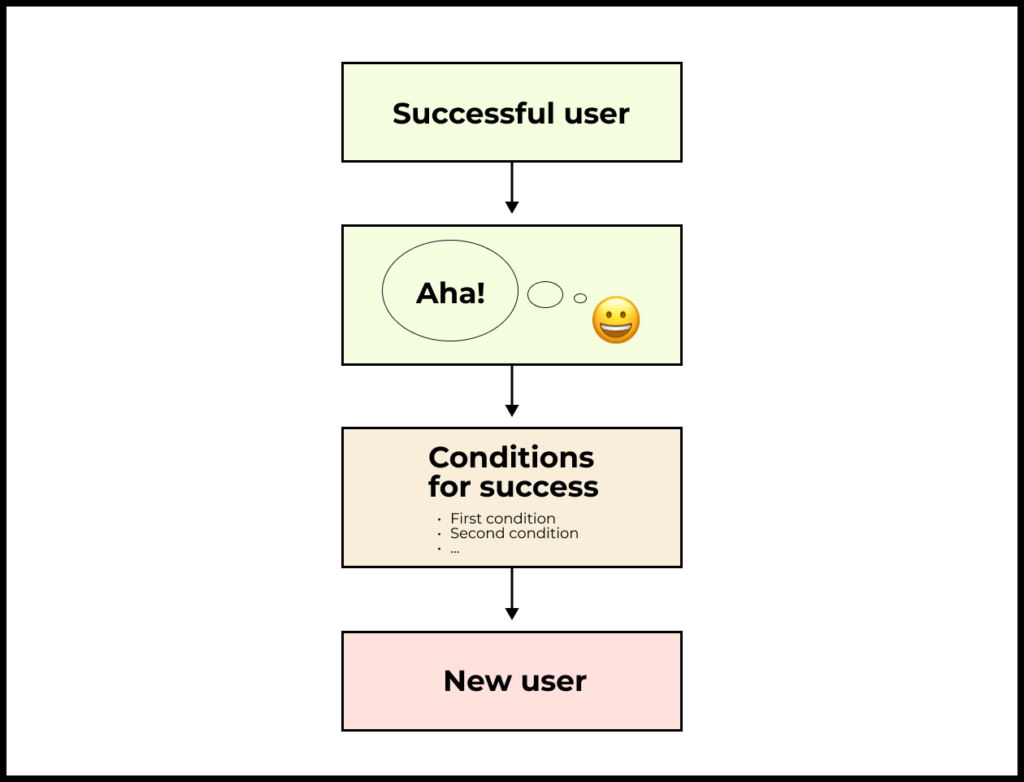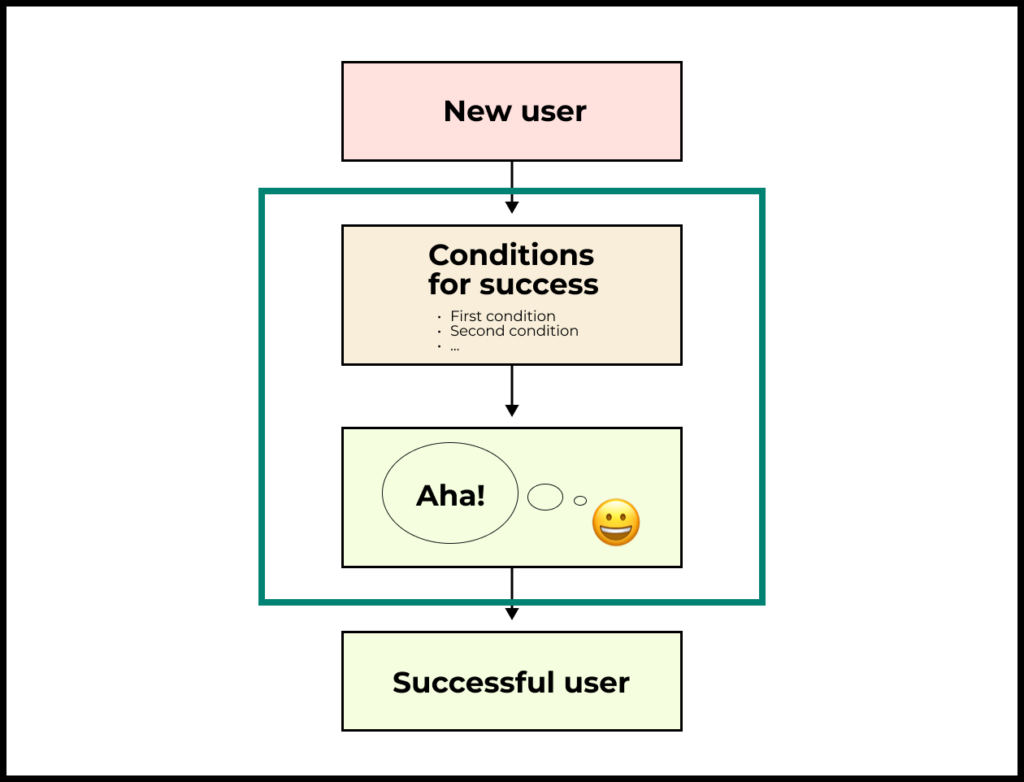This is part of a series of articles on activation and making sure users experience and appreciate your product’s value.
Previously we discussed how to find the “aha moment”—when the user realizes a product’s added value for the first time. In this article, we will talk about how to discover what conditions need to be true before that “aha moment” can happen.
→ Test your product management and data skills with this free Growth Skills Assessment Test.
→ Learn data-driven product management in Simulator by GoPractice.
→ Learn growth and realize the maximum potential of your product in Product Growth Simulator.
→ Learn to apply generative AI to create products and automate processes in Generative AI for Product Managers – Mini Simulator.
→ Learn AI/ML through practice by completing four projects around the most common AI problems in AI/ML Simulator for Product Managers.
All posts from the series
01. When user activation matters and you should focus on it.
02. User activation is one of the key levers for product growth.
03. The dos and don’ts of measuring activation.
04. How “aha moment” and the path to it change depending on the use case.
05. How to find “aha moment”: a qualitative plus quantitative approach.
06. How to determine the conditions necessary for the “aha moment”.
07. Time to value: an important lever for user activation growth.
08. How time to value and product complexity shape user activation.
09. Product-level building blocks for designing activation.
10. When and why to add people to the user activation process.
11. Session analysis: an important tool for designing activation.
12. CJM: from first encounter to the “aha moment”.
13. Designing activation in reverse: value first, acquisition channels last.
14. User activation starts long before sign-up.
15. Value windows: finding when users are ready to benefit from your product.
16. Why objective vs. perceived product value matters for activation.
17. Testing user activation fit for diverse use cases.
18. When to invest in optimizing user onboarding and activation.
19. Optimize user activation by reducing friction and strengthening motivation.
20. Reducing friction, strengthening user motivation: onboarding scenarios and solutions.
21. How to improve user activation by obtaining and leveraging additional user data.
Activation means making a product’s (objective) value resonate in the (subjective) perception of real users. If the product doesn’t create added value, then even the best activation process won’t have results. But if that added value exists and the product has a strong product/market fit, improved activation can be a key lever for boosting growth.
To measure activation, we can use retention or the amount of “work” that the product performs for the average new user. But these metrics aren’t enough by themselves to understand how changes in your product affect the user experience.
That’s why we started looking at the key steps that lead the user down the path of realizing a product’s added value. We’ve taken a successful user in the context of a specific use case and worked backwards to see what conditions made it possible.

Let’s continue that discussion.
Conditions necessary for the “aha moment” to happen
To interest a potential user in your product, you make a sort of promise about how the product will make their life better. Your task during activation and onboarding is to keep this promise and enable users to personally experience this added value for themselves.
Most of the time, before the user can appreciate a product’s value, a number of conditions have to be met. Here we refer to them as the conditions necessary for the “aha moment”. If these conditions aren’t met, the user is extremely unlikely to become successful.
In previous articles, we’ve already considered some of the conditions necessary for the user of a dating app to experience an “aha moment”. These could include:
- If the user doesn’t have a photo in their profile, there is almost no chance that someone will “like” them.
- If nobody else has signed up in the user’s geographic area, then the user is very unlikely to experience value from the app.
- If the user hasn’t liked any other profiles, they will not have any matches, which means no chats and no dates.
How to determine the conditions necessary for the “aha moment”
To determine the conditions that make the “aha moment” possible, we should start with qualitative methods and then fine-tune our hypotheses with quantitative methods.
Here are a few of the key approaches that can help.
Finding conditions whose absence makes user success virtually impossible
Let’s say that you’ve already found some “aha moments” for key use cases in your product. So you have a clear understanding of what “job” your product does and how it creates added value compared to the alternatives on the market.
Most of the time, this is sufficient for determining the conditions necessary for the “aha moment”. We can put the question as: In the absence of which actions and conditions will users not be able to experience value?
We can think of a few things that need to be in place for a company to succeed with Slack:
- If the first user to sign up (the admin) doesn’t invite any colleagues, the odds of company success are effectively zero.
- If none of the invited users creates an account and starts using Slack, the odds of success are effectively zero.
- If the initial users at the company don’t create any channels for talking with their colleagues, the odds of success are effectively zero.
Similarly, we can posit some of the conditions necessary for user success on a mobile chat platform:
- A cell phone number (most mobile chat apps won’t let a user sign up without one)
- Access allowed to contacts (without this, the user will have a hard time finding anyone to talk with in the app)
- Push notifications enabled (otherwise, the user won’t see new messages when the app is backgrounded)
Analyzing sessions of successful and non-successful users
Another useful tool for determining the conditions necessary for the “aha moment” is session analysis.
The first step is to chain events together in your analytics system for users who became successful, as well as for users who did not become successful (dropped out). Then start looking at these chains. Very soon you will start noticing patterns in user behavior.
This approach gives a much more profound look into the user experience and lets you see the product in the way that your users do.
Here are some of the insights that session analysis yielded about the self-serve version of Workplace from Meta, a social platform for company-wide communication:
- Before inviting all of a company’s employees to join, the administrator who created the company’s account would usually try out the product with a small group of colleagues. This was, in effect, a test run for them to see how well Workplace fit their needs.
- When the first users at a company included top management, the likelihood of success increased considerably. Products involving changes to the working processes of large numbers of people require champions with considerable influence within the company.
- Session analysis enabled identifying diversity in activation patterns. Some companies tested out the service with a small group and then invited the rest of the company all at once. But at other companies, the test run stage was followed by gradual and uneven growth over an extended period, without any single moment when the whole team joined.
For an even more detailed picture, you can round out session analysis with in-depth qualitative interviews. This technique gives visibility into what happened off-screen. You can learn which alternatives were considered, what was used previously, which “jobs” are critical to the customer, and which criteria they used to evaluate the product.
Validating conditions necessary for the “aha moment” with quantitative methods
The process for validating the conditions necessary for the “aha moment” with quantitative methods is just like the process for validating “aha moments” themselves.
For the actions you have surfaced with qualitative methods, you want to establish the values of two metrics:
- What percentage of users who performed the given action experienced the “aha moment”?
- What percentage of users who did not perform the given action did not experience the “aha moment”?
Here we want to pay special attention to the second metric, since it directly reflects how critical the action is for achieving success.
After validating key actions, you use them to formulate metrics for subsequently analyzing user behavior and measuring the impact of product changes. In most cases you will want to use one of the following formats for your metrics:
- What percentage of new users performed the given action?
- For what percentage of new users was the given condition true?
Pivotal actions and metrics for the activation process
What we’ve done is take a successful user (in the context of a specific use case) and worked backwards to find two things:
- The “aha moment”, when the user personally experiences your product’s added value for the first time.
- Conditions necessary for that “aha moment” to happen.
These pivotal actions and points are at the core of user activation. By knowing them, you can determine how well different versions of the onboarding process articulate value to users.









